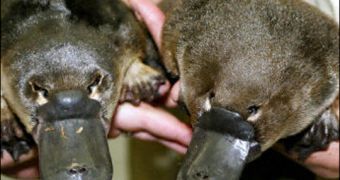The platypus is by far the strangest mammal, with its bird-like bill and reptile traits. Its genetics seems to be equally strange, as revealed by a new research published in the Nature journal and carried out by Prof Chris Ponting's team at the Medical Research Council Functional Genomics Unit in Oxford, the European Molecular Biology Laboratory's European Bioinformatics Institute in Cambridge and the Genome Sequencing Centre of Washington University School of Medicine.
The platypus (Ornithorhynchus anatinus) is a real mammal, with fur and milk, but what makes it so special is that it lays eggs like reptiles and other reptilian characters (seen in many bones). The bill resembles that of a duck only superficially and has a complex electrosensory system that helps it forage underwater, as the animal swims with its eyes, ears and nostrils closed. Male platypuses have spurs on their hind legs connected to glands releasing a powerful venom.
170 Ma ago, platypuses split off from the lineage that evolved into placental mammals, humans included. The study represents "the missing link in our understanding of how we and other mammals first evolved. This is our ticket back in time to when all mammals laid eggs while suckling their young on milk," said Professor Ponting from the MRC Functional Genomics Unit at the University of Oxford.
"The study shows that platypus venom is a cocktail of proteins that originally had very different functions, such as fighting infection by microbes. Amazingly, the same proteins are also found in reptile venom even though platypus and snake venom evolved independently, converging on the same solution to how to defend themselves," said Dr Ewan Birney, who led the analysis effort at the European Bioinformatics Institute.
The research found that the platypus has 5 times more sex chromosomes than other mammals and humans do. Humans possess 2 sex chromosomes - a man has an X and an Y (XY), a woman a pair of X (XX). But the platypus has 10: the female has 5 different pairs of X, while males have 5 X and 5 Y). Even weirder, some platypus sex chromosomes resemble those found in birds, whereas others are more similar to the mammalian ones. Moreover, the Y chromosome of the platypus lacks the masculinizing gene SRY found in all placental mammals and humans.
"We expected that platypus - although they had slightly weird looking sex chromosomes - be basically the same. But they're absolutely not. There's no copy of this gene. The platypus of course is not an evolutionary intermediate. But it's the comparisons of humans with the platypus that can tell us about the fork in the road, when the platypus went one way and we went another way." said co-author Prof Jenny Graves, Australian National University.
The genome of the platypus was compared with that of humans, mice, dogs, opossums and chickens, and some sequences of it with genome sequences of the anolis lizard. The platypus was found to have the same number of protein-encoding genes like placental mammals: around 18,500. Over 80% of these genes are common to both this animal and humans. For example, in the case of egg fertilization, the platypus has a mix of both reptilian and mammalian genes. Like other mammals, the platypus possesses a set of genes encoding for the milk protein, the casein.
Most mammals have a well developed olfaction, but the platypus shuts its nostrils when diving for food. Still, its genome possesses much more smell receptors than those of any other mammal. At the moment, researchers can only speculate on that the animal uses 'vomeronasal receptors' (located on the roof of the mouth) to smell underwater. Snakes and lizards also use these receptors for olfaction.

 14 DAY TRIAL //
14 DAY TRIAL //